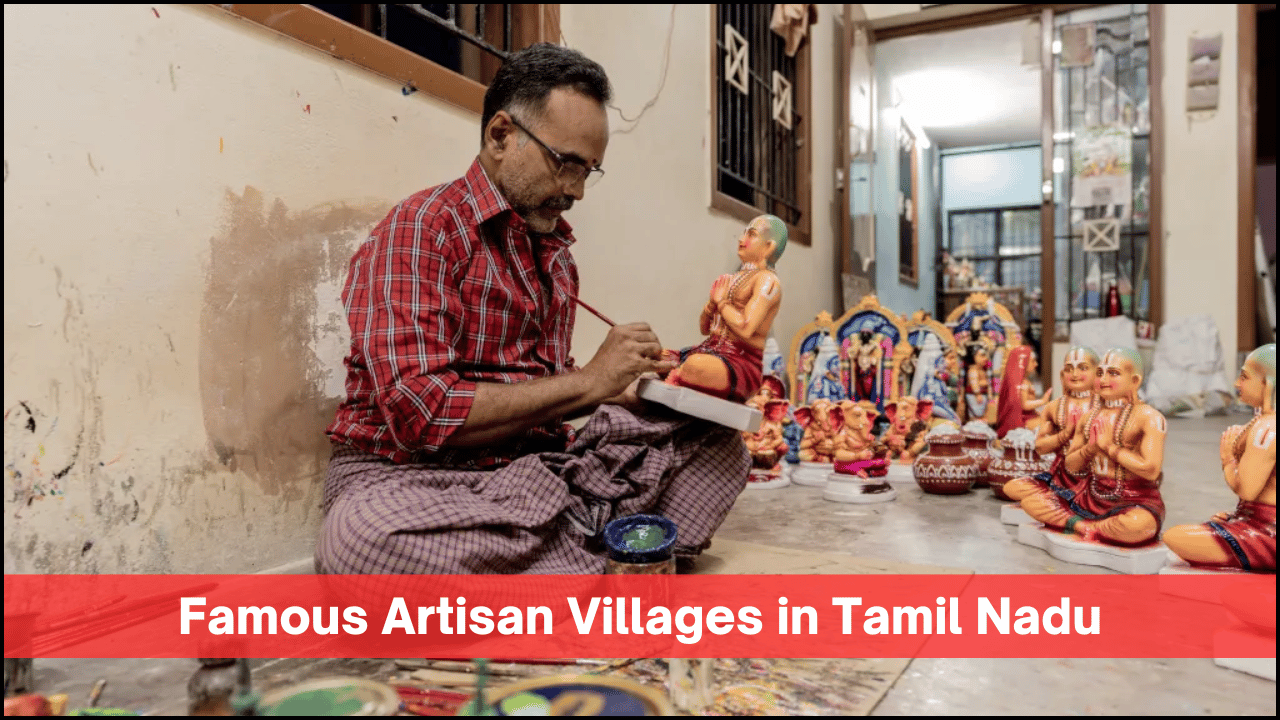
The Tamil Nadu Handicrafts, Handlooms and Food Exhibition is a colorful and vibrant celebration of traditional skills, local culture, and tasty food. The event showcases the creativity, hard work, and talent of artisans, weavers, and chefs from across the state.
Table of Contents
Main Highlights of the Exhibition
- Handicraft stalls display beautiful wooden, metal, and stone items made by skilled artisans.
- Handloom products include cotton sarees, silk fabrics, and traditional garments.
- Food stalls offer local Tamil dishes, sweets, snacks, and beverages.
- Live demonstrations show how crafts are made, how weaving is done, and how food is prepared.
- Cultural performances like folk music and dance add to the festive mood.
- Government support helps promote rural employment and preserve heritage.
Handicrafts Section
The handicrafts section is filled with artistic products made using traditional tools and natural materials.
Types of Handicrafts Displayed
| Handicraft Type | Description |
|---|---|
| Wood Carvings | Sculptures, idols, and furniture carved from teak and rosewood. |
| Tanjore Paintings | Traditional gold-foil paintings with religious themes. |
| Stone Sculptures | Idols made from granite and soft stones like soapstone. |
| Metal Crafts | Brass lamps, bells, and puja articles. |
| Terracotta Products | Pots, vases, and figurines made of baked clay. |
| Palm Leaf Articles | Baskets, mats, and wall hangings made from palm leaves. |
- Craftsmen from rural villages bring authentic, handmade items.
- Visitors get a chance to interact with artisans and learn their stories.
- Live workshops allow people to try craft-making techniques.
Handloom Section
The handloom section represents the pride of Tamil Nadu’s weaving communities. The handwoven fabrics carry tradition, color, and comfort.
Famous Handloom Products
| Handloom Type | Origin | Special Features |
|---|---|---|
| Kanchipuram Silk Sarees | Kanchipuram | Rich colors, gold zari borders |
| Chettinad Cotton Sarees | Chettinad | Bold patterns, contrasting borders |
| Madurai Sungudi Sarees | Madurai | Tie-and-dye technique, lightweight |
| Erode Cotton Fabrics | Erode | Fine cotton used for shirts and dhotis |
| Coimbatore Towels | Coimbatore | Soft, absorbent, durable |
- Weavers show skills passed down through generations.
- Natural dyes and eco-friendly threads are commonly used.
- Affordable prices make it easier for all to buy handmade clothes.
Food Section
The food section attracts large crowds due to the tempting smell and delicious taste of Tamil cuisine.
Popular Food Items at the Exhibition
| Food Item | Type | Description |
|---|---|---|
| Idlis and Dosas | Breakfast | Served with chutney and sambar |
| Pongal | Festive Dish | Made with rice, ghee, and spices |
| Kothu Parotta | Street Food | Spicy shredded parotta mix |
| Chettinad Chicken | Non-veg Curry | Famous spicy chicken gravy |
| Kozhukattai | Sweet/Snack | Steamed rice dumplings |
| Filter Coffee | Beverage | Strong, aromatic South Indian coffee |
- Homemade pickles, podis (spice powders), and sweets are sold in packets.
- Chefs from villages prepare food using traditional methods.
- Food counters maintain hygiene and offer seating for families.
Cultural and Entertainment Events
The exhibition is not just about shopping and eating. It also offers entertainment and cultural programs.
- Folk dances like Karagattam, Oyilattam, and Kavadi are performed.
- Musicians play classical instruments such as Nadaswaram and Thavil.
- Street plays spread social messages with humor and songs.
- Children enjoy puppet shows, storytelling sessions, and painting contests.
Educational and Interactive Activities
The exhibition serves as a learning place for students, tourists, and craft lovers.
- Workshops teach skills like pottery, painting, and weaving.
- Storyboards and posters explain the history of each craft and region.
- School visits are organized to help students learn about their heritage.
Support and Promotion
The exhibition is usually organized by the Tamil Nadu Handicrafts Development Corporation (Poompuhar) and supported by various government departments.
- Subsidized stalls are provided to rural artisans.
- Special awards are given to the best craftspeople.
- Online platforms help promote crafts digitally.
- Media coverage helps attract more visitors and buyers.
Benefits of the Exhibition
The exhibition has many positive impacts on society and the economy.
Social and Economic Benefits
| Benefit Type | Description |
|---|---|
| Employment | Artisans and weavers earn income from direct sales. |
| Tourism | The event attracts tourists from other states and countries. |
| Cultural Awareness | Visitors learn about Tamil traditions and arts. |
| Women Empowerment | Many women’s self-help groups take part and earn an income. |
| Skill Preservation | Old skills stay alive through training and workshops. |
Visitors’ Experience
The exhibition offers a rich and colorful experience for every age group.
- Families enjoy the safe environment, tasty food, and shopping options.
- Art lovers find rare handmade items and get to meet creators.
- Tourists take back souvenirs and memories of Tamil culture.
- Students learn by observing live work and interacting with experts.
Final Analysis
The Tamil Nadu Handicrafts, Handlooms and Food Exhibition is more than a trade fair. It is a celebration of culture, creativity, and community. Through this platform, traditional skills are preserved, rural artisans are supported, and cultural pride is promoted. Every year, thousands of people visit this exhibition to connect with the roots of Tamil Nadu’s rich heritage.





